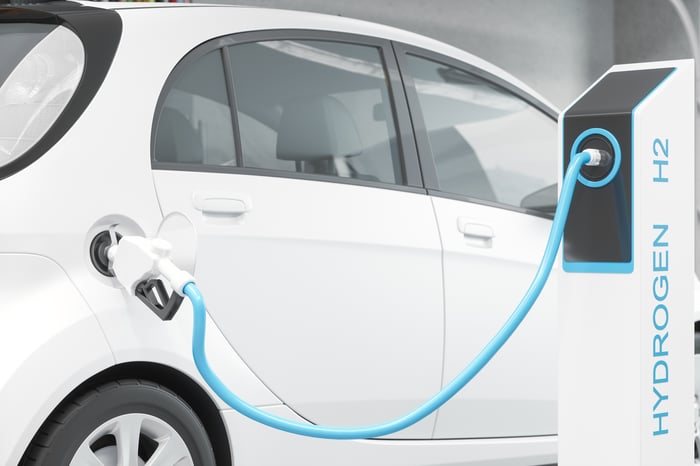Fuel cell stocks have surely captivated investors' attention recently. The growth in renewables has increased the demand for energy storage, as generation from renewable sources tends to be intermittent. While batteries are right now most widely used for energy storage, there is a sizable, and growing, demand for fuel cells too. Both Plug Power (PLUG 7.49%) and Bloom Energy (BE -3.28%) are poised to benefit from this trend. But one looks better than the other right now. Let's see why.
Offerings
Plug Power's fuel cells differ considerably from those of Bloom Energy. Plug Power offers proton exchange membrane, or PEM, fuel cells, which is the most common fuel cell technology in use currently. It requires a platinum catalyst, which makes it expensive. Moreover, platinum is extremely susceptible to impurities present in fossil-fuel derived hydrogen. So, PEM fuel cells also require an additional reactor to reduce carbon monoxide present in hydrogen fuel, adding to the cost. However, PEM fuel cells are compact, can start or stop quickly, and can operate at lower temperatures. All these characteristics make them more suitable for transportation applications.

Image source: Getty Images.
In comparison, Bloom Energy uses solid oxide fuel cell technology. Solid oxide fuel cells can operate using biogas or natural gas and are more cost-effective and efficient. However, they operate at very high temperatures and take more time to start compared to PEM fuel cells. Lower costs and higher efficiency make these fuel cells suitable for stationary baseload power generation.
Bloom Energy has so far been providing fuel cells running on bio and natural gas. However, it has now started delivering fuel cells that use renewable hydrogen as input.
Target market
Bloom Energy's key value proposition is lower-cost fuel cells with greater efficiency. These are useful in stationary utility applications. Bloom Energy has partnered with SK Engineering & Construction (a subsidiary of South Korea's leading industrial conglomerate SK Group) to sell fuel cells in the stationary utility and commercial and industrial market in Korea. Other areas where hydrogen fuel cells can be particularly useful are shipping and aviation. Bloom Energy has partnered with Samsung Heavy Industries to replace oil-based power on its large cargo ships with solid oxide fuel cells.
In comparison, Plug Power primarily targets the transportation market for its fuel cells. Its fuel cells are used by Amazon, Home Depot, and Walmart in their forklifts. It's also targeting European car manufacturers, which are investing in developing hydrogen fuel cell-powered vehicles. Plug Power's planned joint venture with Renault is a huge breakthrough and may set the company firmly on the path to profitability.
Additionally, the company has also recently entered into a strategic partnership with SK Group where it will provide fuel cells and electrolyzers (units to produce hydrogen using water) to the Korean and Asian markets. South Korea's government aims to put 6 million fuel cell vehicles on the road by 2040. If things go well, the two companies may enter into a formal joint venture by 2022.
Outlook
Hydrogen is getting a lot of policy support in Europe and East Asia, mainly Japan and Korea. The European Commission envisions 13% to 14% of Europe's energy coming from hydrogen by 2050. Still, there is a need for wider adoption of fuel cells as well as the supporting infrastructure to allow fuel cell companies to operate at scale and profitably.
Plug Power has been offering hydrogen fuel cells for years. It hasn't been profitable so far despite prominent customers, but it has bright prospects due to falling costs and increased adoption of hydrogen fuel cells. The company aims to generate positive operating income by 2024. With the latest Renault and SK Group partnerships, it looks better-placed to achieve that target. I would expect that the EV segment, that Plug Power would be entering with the Renault partnership, won't be as cost-sensitive as the forklifts market. This should bode well for the company's bottom-line.
Bloom Energy has entered into the hydrogen market recently. It is targeting a different market where battery technology has not been very successful so far. It's an evolving market, and success depends on the company's ability to offer easy-to-use, cost-effective customized solutions. Bloom Energy targets 15% operating margin by 2025. It also seems to be moving in the right direction to achieve that.
Valuation
Bloom Energy beats Plug Power on the valuation front. The stock is trading at a price-to-sales ratio of around six, compared to Plug Power's lofty ratio of 70. The huge valuation gap could be because Bloom Energy has only recently forayed into the hydrogen segment and has yet to prove that it can be profitable there. It has so far been providing bio-gas and natural gas based fuel cells. While Plug Power also hasn't achieved profitability yet, it is an experienced player in hydrogen fuel cell technology and has already entered into the huge potential hydrogen EV market. The company has been growing sales at an average rate of 35% over five years and may grow at a faster pace in the coming years.
PLUG Revenue (Quarterly) data by YCharts
Note that both Plug Power and Bloom Energy face significant risks. Fuel cell technology may not receive the kind of adoption the companies, and investors, are hoping for. Though promising, the technology has not been successfully commercialized yet despite being around for decades. Falling costs of lithium-ion batteries may restrict fuel cell growth in the future too. Besides, the two companies may face significant competition resulting in margin pressures. In particular, this last point makes me uncomfortable about Plug Power's lofty valuation. In comparison, Bloom Energy offers a similar growth potential at a much saner valuation. That makes it a better buy right now. Although, considering the risks involved, conservative investors might want to stay away from both the stocks at the moment.






